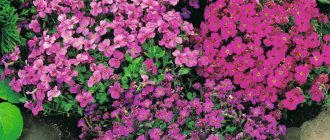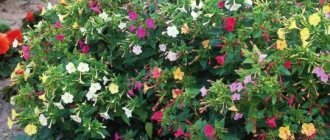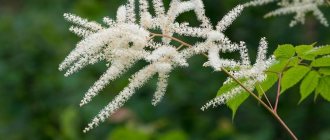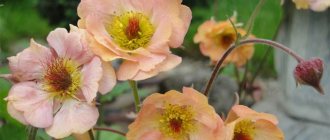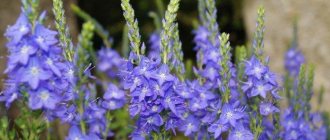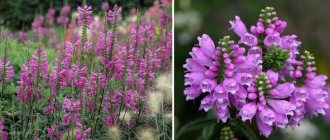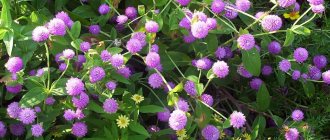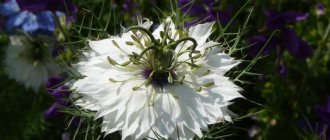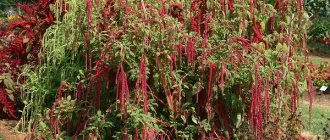Alyssum is a genus that includes more than 100 varieties of various plants, of which only a few have found recognition in the eyes of gardeners and are often found in gardens. Alyssum (Alyssum, Lobularia) belongs to the family of cruciferous plants - Brassicaceae.
The small, abundantly flowering alyssum is one of the least demanding ornamental plants. In the article we will look at and learn the main advantages of alyssum, features of planting and care, photos of popular species and varieties.
Short description
In spring, rocky garden beds will be pleased with golden-yellow flowers; from summer to autumn, we will be delighted by sea alyssum with white, pink or purple flowers. The flowers are small but numerous, located on one stem, collected in so-called clusters. Shoots with flowers reach a length of 30 cm, growing from a rosette of oblong leaves of grayish-green color.
Pests
The most dangerous enemy of alyssum is the cruciferous flea beetle . It can be dealt with by treating the plant with a solution of vinegar essence (1 tablespoon per 10 liters of water). No less dangerous are turnip whites and cabbage moths . The means to combat them are “Lepidotsid” or “Entobacterin”.
To prevent the invasion of other insects, it is useful to periodically treat the plant with an infusion of chamomile or a solution of tobacco with laundry soap. But you shouldn’t get carried away with chemicals. After all, bees love to visit alyssum, and chemical treatments are extremely destructive for them.
Popular types of alyssum
Below are popular types of lobularia with photos.
Silver (Alyssum argenteum)
A perennial, reaching approximately several tens of centimeters in height, its natural habitat is the European continent. It is distinguished by decorative yellow inflorescences and long, lanceolate silver-gray-green leaves.
Borage alyssum (Alyssum alyssoides)
Perennial plant, 30 cm high, with low requirements. Natural habitats - Southern Europe, Caucasus. Grows in roadside ditches and thickets. The flowers are yellow, the leaves are lanceolate, gray, shaggy.
Rocky (Alyssum saxatile)
Grown in gardens, a variety with high decorative qualities. Few requirements for habitat. In April it becomes covered in thousands of yellow flowers, creating interesting cushions of sunshine that contrast well with other flowers, such as purple phlox. Native to mountainous regions of Europe and Asia. Shrub with woody shoots. Flowers are collected in a panicle. The leaves are lanceolate, gray-green. The bush reaches a height of 30 cm. After flowering, if the plant does not need to produce seeds, we cut off the flowers and wait for flowering again.
The perennial rock species grow well, producing yellow fields of flowers when in bloom. When the inflorescences turn red, it is worth cutting off the stems. Then the leaves covered with silver hair become a decoration; flowers may appear again in early autumn.
Mountain Alyssum (Alyssum montanum)
A perennial characteristic of the European landscape. It takes on a creeping form, the bushes reach a height of 20 cm. Yellow flowers are collected in clusters. The leaves are gray-green, lanceolate. It is considered a long-lived plant.
Marine lobularia - marine alyssum (Alyssum maritimum, Lobularia maritima)
An annual plant with very varied uses. Planted in the garden, in boxes, pots on the balcony, terrace. Forms compact, very branched, flowering bushes. Blooms profusely in summer in colors - white, yellow, pink, purple. After pruning it blooms again, so you can extend the flowering period. Reaches a height of 20-30 cm, characterized by bright flowers collected in clusters. The leaves are lanceolate, covered with hairs.
Sea varieties have a very pleasant, slightly sweet aroma of honey. Most often they are white, but are also found in shades:
- pink;
- purple;
- dark burgundy.
There are varieties with leaves bleached white or creamy.
Ampel varieties of alyssum
During the season, the plant grows, the stems droop, and the alyssum takes on a drooping shape.
Ampelous alyssum, photo
The marine species includes a whole group of varieties with the collective name ampelous. These varieties look great in the garden, on the balcony, on the terrace. The name ampelous is associated with the shape of the plant, which has characteristic, slightly drooping, twisting shoots, covered with beautiful flowers during the flowering of alyssum. Proper pruning of hanging varieties will help create an interesting sphere that looks beautiful when let loose.
Flowers work great on verandas and in hanging pots. In the garden, they can be planted on top of stones so that the shoots fall well. Ampelous alyssum stands out in every garden and is very popular.
The most common types of garden borers are:
- mountain;
- nautical;
- rocky;
- silver.
Diseases
If alyssum grows in heavy and waterlogged soil, it suffers from rot , and both shoots and roots are susceptible to it. You need to dig up the plant and replant it in well-drained soil.
late blight can develop , which affects the root collar and underground part. In this case, you can try to cure alyssum by treating it with fungicides. Another possible disease is powdery mildew . It can be cured with Bordeaux mixture.
You can read about these diseases and methods of protection here.
Alyssum flowers - decorative qualities
Perennial and annual alyssum deserve attention; they are characterized by abundant flowering and low cultivation requirements. The most common varieties in our gardens begin to bloom in April - rock and mountain alyssum. In May, the rocky species ends flowering; in June, the mountain species ends, but the silver and sea species begin to bloom. Silver blooms until August, sea, depending on the sowing date, until autumn. Flowering in autumn replicates the mountain look.
All mentioned species, except the marine one, are perennial plants. Sea alyssum is an annual plant.
Popular varieties of alyssum
| Species name | Variety name, photo | Description |
| Nautical | "Violet Queen" "Violet Queen" | Alyssum with small flowers in shades of purple and lilac. |
| Nautical | "Royal Carpet" | The variety reaches a height of 20 cm, with purple-white flowers. |
| Rocky | "Plenum" | A very valuable variety due to its full flowers. |
| Nautical | "Snow Carpet" | Alyssum is an annual white plant characterized by white flowers. |
| Nautical | "Rosie O'Day" | A variety with flowers in shades of red and pink. |
| Rocky | "Compactum" | A variety that blooms richly with golden yellow flowers and is compact. |
| Rocky | "Citrinum" | A variety that blooms with lemon flowers. |
| Rocky | "Gold placer" | A ground cover variety of alyssum with yellow, small flowers. |
| Rocky | "Golden Wave" | Alyssum is spreading, low growing, blooming profusely. |
| Rocky | "Big Jam" | Alyssum with large flowers of purple, lilac, white. |
| Nautical | "Oriental Night" | Variety with dark purple flowers |
| Nautical | "Snow Queen" | Multiple winner of many exhibitions. Cold-resistant annual, blooms with small flowers in various shades: pink, red, white, yellow, purple. Compact, spreads beautifully, blooms profusely throughout the season. Recommended for balconies, tall pots, hanging baskets. Planted in the ground it will produce a carpet of flowers. |
Peculiarities
Alyssum has rather spreading branched stems. The leaves are small, oval-shaped, covered with down. Alyssum root grows close to the surface of the earth. It is fibrous and small in size. Alyssum flowers are inflorescences with a rich palette of colors. Most often you can find alyssum in white, yellow or pink colors. Alyssum hides its seeds in small pods that appear in the fall.
When properly stored, alyssum seeds remain viable for 3 years. Alyssum is an excellent honey plant, so there are always a lot of bees on its flowers. Alyssum has a long flowering period: it begins at the end of May and ends in late autumn. Wild varieties are colored only yellow, but cultivated species have a much wider range of colors.
Growing and care
Lobularia does not belong to the demanding ornamental plants. She prefers sunny or slightly shaded positions. Garden flowers of perennial alyssum are completely resistant to frost; the marine species is considered an annual plant.
Soil requirements
Alyssum soil requirements:
- permeable;
- light;
- preferably drained;
- alkaline or neutral.
Rocky species are completely frost-resistant and have no special soil requirements, although it is better to choose permeable and even rocky soil. Clay soil is also suitable. Rocky varieties are accustomed to infertile, rocky soils, so they do not need fertilizers, but they do need liming of the substrate.
Where to plant rock species?
Sea and rock varieties are united by a passion for the sun; sea varieties are somewhat more demanding in cultivation.
Rocky varieties can be planted in flowerbeds; they also grow well on stones, to which the flower is especially suitable, due to its origin. They can also be used to line stone walls. It is worth using the preference of a plant that grows best in dry and sunny places - few flowers can withstand such conditions, especially without additional care.
Watering, fertilizers and stimulants
Watering and fertilizing alyssum is carried out depending on needs. Rock alyssum does not need to be irrigated. If the summer is sunny and dry, the flowers will bloom again in September.
Attention! Alyssums, especially rocky ones, do not tolerate waterlogging of the soil. It is necessary to ensure that stagnation of water does not form, otherwise this can lead to root rot.
After flowering and cutting the plants, it is worth watering them with a liquid multi-component fertilizer for flowering plants to stimulate re-blooming.
Pests and diseases
Alyssum is not very vulnerable to diseases and pests. Among insects, the cruciferous flea beetle can cause problems - a small insect 2-3 mm in size, feeds on leaves, and on hot days can destroy seedlings in 3-4 days.
Ways to fight:
- agrotechnical - weeding of weeds that serve as food for flea beetles;
- early sowing dates in cloudy weather;
- chemical - used when 10% of the bushes are affected - spraying with insecticides: karate 5%, zolon 35% or modern analogues.
During rainy periods or with excessive watering, the roots of alyssum are affected by root rot, and the leaves are covered with a white-gray coating - powdery mildew. Root rot is manifested externally on the plant by yellowing of the leaves. Sick plants are dug up, then the rhizome is washed with a weak solution of potassium permanganate, and be sure to be transplanted to another bed. For powdery mildew, you can treat the leaf with a fungicide solution - topaz 10%, caratan 18%.
Trimming
Sometimes alyssium stops flowering. It happens that sea varieties stop blooming. Then you need to cut off the stems with faded flowers - after about 2-3 weeks the flowers should bloom again. The sea varieties have a delicate appearance, accustomed to warmer climates because they come from regions near the Mediterranean, but are surprisingly resistant to autumn cold. If there were no severe frosts, flowering would take place even until mid-December (in balcony pots).
Trimming
Alyssum responds positively to pruning. In the spring, last year's flower stalks, dried leaves and weak branches are removed from perennials.
Timely pruning gives the bushes a well-groomed appearance and increases flowering time.
After the bushes have flowered, they are trimmed again , but not more than by one third, which is often a stimulus for re-blooming.
It is important to remove all faded inflorescences to simulate the growth of the bush and the appearance of new lacy “clouds”.
Reproduction
Perennial species can reproduce in several ways:
- seed propagation method;
- layering;
- dividing the bush;
- seedlings (saplings).
In the case of rock species, separation of plants, especially old ones, is at risk.
Propagation of alyssum - growing from seedlings
Marine alyssum (annual) is sown in open ground from April to May in a permanent place directly into the ground. You can prepare seedlings in containers in advance. It is better to sow alyssum in rows with a distance of 15-20 cm. After planting the seeds for seedlings, seedlings appear that need to be thinned out, leaving plants every 5 centimeters. The seeds germinate in about a week. Flowers bloom approximately 2 months after sowing.
It is important to know when to collect alyssum seeds. Seeds are collected at the end of September after flowering. The inflorescences are rubbed between your fingers, separating the seeds, and dried thoroughly.
Method of planting by layering and cuttings
More often, alyssums are propagated by layering, which should be stored in a warm place in water. If they send out roots, they need a lot of air and aeration. This method is quite labor-intensive and does not always work.
Rock and mountain varieties are propagated by cuttings made from semi-lignified shoots (they are taken in August and after rooting in September, they are planted).
Propagation by seedlings
Seedlings and even flowering alyssums can be purchased at most garden centers. They are sold primarily in May, but can be found throughout most of the season. Seedlings are planted in groups of 2-3 plants at a distance of 30 cm, which gives 11 plants per 1 square meter. The space between them can fill up quickly because the bushes spread quickly.
Perennial alyssums can be sown directly into the ground, but propagation from cuttings makes it easier to develop a design.
When to plant alyssum for seedlings in 2022
The approximate time for sowing the crop is March. But in this matter it is very important to take into account territorial features due to different climate conditions:
- In the southern regions, you can plant it as early as mid-February.
- In the central zone (including the Moscow region) - it is better to plant in early March.
- In Siberia, the Urals, and the Leningrad region, it is optimal to sow in mid-March.
Note! The terms indicated above apply more to annual crops. If you purchased the seeds of perennial alyssum, then planting should be done earlier, since such seeds require more time to germinate and develop normally.
To select a more accurate time for the procedure at home, you can focus on the timing of sowing alyssum according to the 2022 Lunar calendar:
- Favorable days for the procedure: in January: 1, 10, 11, 15, 16, 19, 20;
- in February: 7, 8, 12, 13, 14, 15;
- in March: 10, 11, 15, 20, 21, 24, 25.
- Unfavorable days for planting: in January: 2, 18th;
- in February: 1, 16;
- in March: 2, 16, 17, 18, 31.
Application in landscape design
Alyssum is an excellent proposal for climbing frames, borders and perennial flower beds.
Alyssum on rocks, photo
They are also suitable for growing in containers on the terrace, balcony, especially the sea view. Sea varieties look great in flower beds. Since they are low, they also look very good in pots and hanging baskets. You can successfully grow them on balconies and terraces, especially on the south side, not shaded by trees or buildings. When planting on balconies or in large pots, place them near the edge of the container to allow the stems to hang freely.
Rock borage combines well with other spring perennials, such as phlox.
Alyssiums are very beautiful flowers - both annual marine species and perennial rocky ones. They look different, but bloom beautifully and are not demanding. These are small, purely ornamental plants, including many species, completely different from each other. Alyssum is relatively unpretentious to conditions and soils, so it often becomes an inhabitant of flower beds, rock gardens, and decoration of balconies and terraces.
What you need to prepare for planting alyssum at home
Container for sowing and growing alyssum seedlings. It is best to sow seeds in a wide, but not very high (about 6-7 cm) container. For example, it could be a wooden or plastic box, an ordinary food bowl (container). It is necessary that there are drainage holes at the bottom of the container to remove moisture.
The soil for alissum seedlings must have a number of characteristics: be loose, light, air- and moisture-permeable. A universal soil mixture for flower seedlings is suitable for these purposes. You can also prepare the soil with your own hands: lowland peat, sand, and humus are mixed in equal parts. Before planting, it is recommended to disinfect the soil.
alyssum seeds from trusted manufacturers who have a good reputation. In addition, special attention should be paid to the place of purchase: it can be either a garden center or a store, or an online store, the only thing is that they also have a good name and good reviews.
The seeds of this crop do not need special preparation, since in general they have good germination.

